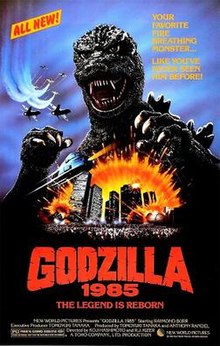
Godzilla is a fictional monster, or kaiju, that debuted in the eponymous 1954 film, directed and cowritten by Ishirō Honda. The character has since become an international pop culture icon, appearing in various media: 33 Japanese films produced by Toho Co., Ltd., five American films, and numerous video games, novels, comic books, and television shows. Godzilla has been dubbed the King of the Monsters, an epithet first used in Godzilla, King of the Monsters! (1956), the American localization of the 1954 film.
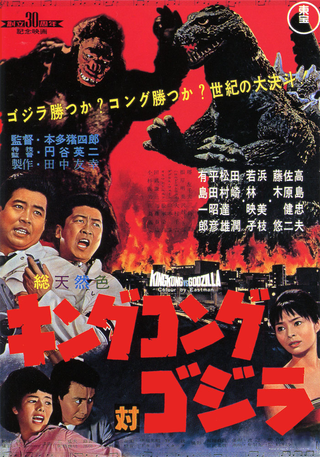
King Kong vs. Godzilla is a 1962 Japanese kaiju film directed by Ishirō Honda, with special effects by Eiji Tsuburaya. Produced and distributed by Toho Co., Ltd, it is the third film in both the Godzilla and King Kong franchises, as well as the first Toho-produced film featuring King Kong. It is also the first time that each character appeared on film in color and widescreen. The film stars Tadao Takashima, Kenji Sahara, Yū Fujiki, Ichirō Arishima, and Mie Hama, with Shoichi Hirose as King Kong and Haruo Nakajima as Godzilla. In the film, Godzilla is reawakened by an American submarine and a pharmaceutical company captures King Kong for promotional uses, culminating in a battle on Mount Fuji.

Son of Godzilla is a 1967 Japanese kaiju film directed by Jun Fukuda, with special effects by Sadamasa Arikawa, under the supervision of Eiji Tsuburaya. Produced and distributed by Toho Co., Ltd, it is the eighth film in the Godzilla franchise. It stars Tadao Takashima, Akira Kubo, Akihiko Hirata, and Beverly Maeda, with Hiroshi Sekita, Seiji Onaka, and Haruo Nakajima as Godzilla, and Marchan the Dwarf as Minilla.
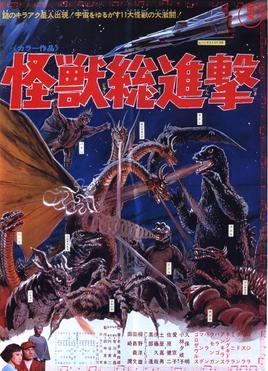
Destroy All Monsters is a 1968 Japanese epic kaiju film directed by Ishirō Honda, with special effects directed by Sadamasa Arikawa and supervised by Eiji Tsuburaya. The film, which was produced and distributed by Toho Co., Ltd, is the ninth film in the Godzilla franchise, and features eleven monster characters, including Godzilla, Mothra, Rodan, King Ghidorah, Anguirus, and Minilla. The film stars Akira Kubo, Jun Tazaki, Yukiko Kobayashi and Yoshio Tsuchiya.

Godzilla vs. Megalon is a 1973 Japanese kaiju film directed by Jun Fukuda, written by Fukuda and Shinichi Sekizawa, and produced by Tomoyuki Tanaka, with special effects by Teruyoshi Nakano. Distributed by Toho and produced under their effects subsidiary Toho–Eizo, it is the 13th film in the Godzilla franchise, and features the fictional monster characters Godzilla, Megalon, and Gigan, along with the mecha character Jet Jaguar. The film stars Katsuhiko Sasaki, Hiroyuki Kawase, Yutaka Hayashi, and Robert Dunham, alongside Shinji Takagi as Godzilla, Hideto Date as Megalon, Kenpachiro Satsuma as Gigan, and Tsugutoshi Komada as Jet Jaguar.

Godzilla vs. Biollante is a 1989 Japanese kaiju film directed and written by Kazuki Ōmori, with special effects by Kōichi Kawakita. Distributed by Toho and produced under their subsidiary Toho Pictures, it is the 17th film in the Godzilla franchise, the second film in the franchise's Heisei period, and a sequel to 1984's The Return of Godzilla. The film stars Kunihiko Mitamura, Yoshiko Tanaka, Masanobu Takashima, Megumi Odaka, Toru Minegishi, Yasuko Sawaguchi, Toshiyuki Nagashima, Yoshiko Kuga, Ryunosuke Kaneda and Kōji Takahashi. This was Odaka's first appearance in the Godzilla franchise as Miki Saegusa, and would reprise the role in every film for the remainder of the Heisei series.

Terror of Mechagodzilla is a 1975 Japanese kaiju film directed by Ishirō Honda, written by Yukiko Takayama, and produced by Tomoyuki Tanaka and Henry G. Saperstein, with special effects by Teruyoshi Nakano. Distributed by Toho and produced under their effects subsidiary Toho–Eizo, it is the 15th film in the Godzilla franchise, serving as a direct sequel to the 1974 film Godzilla vs. Mechagodzilla, the final film in the initial Showa Era of the franchise before Godzilla returned nine years later in The Return of Godzilla, directed by Ishirō Honda and scored by Akira Ifukube before their deaths.
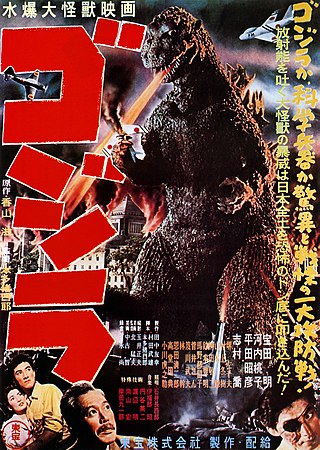
Godzilla is a 1954 Japanese epic kaiju film directed and co-written by Ishirō Honda, with special effects by Eiji Tsuburaya. Produced and distributed by Toho Co., Ltd., it is the first film in the Godzilla franchise. The film stars Akira Takarada, Momoko Kōchi, Akihiko Hirata, and Takashi Shimura, with Haruo Nakajima and Katsumi Tezuka as Godzilla. In the film, Japan's authorities deal with the sudden appearance of a giant monster, whose attacks trigger fears of nuclear holocaust in post-war Japan.

The Return of Godzilla is a 1984 Japanese kaiju film directed by Koji Hashimoto, with special effects by Teruyoshi Nakano. Distributed by Toho and produced under their subsidiary Toho Pictures, it is the 16th film in the Godzilla franchise, the last film produced in the Shōwa era, and the first film in the Heisei series. In Japan, the film was followed by Godzilla vs. Biollante in 1989.

Godzilla vs. Hedorah is a 1971 Japanese kaiju film directed by Yoshimitsu Banno, with special effects by Teruyoshi Nakano. Produced and distributed by Toho Co., Ltd., it is the 11th film in the Godzilla franchise, and features the fictional monster characters Godzilla and Hedorah. The film stars Akira Yamauchi, Toshie Kimura, and Hiroyuki Kawase, and features Haruo Nakajima as Godzilla and Kenpachiro Satsuma as Hedorah. Satsuma would go on to portray Godzilla in later Godzilla films.

Invasion of Astro-Monster is a 1965 kaiju film directed by Ishirō Honda, with special effects by Eiji Tsuburaya. It is the sixth film in the Godzilla franchise and Shōwa period. The film was a Japanese-American co-production; it was the second collaboration between Toho Co., Ltd. and UPA. The film stars Akira Takarada, Nick Adams, Kumi Mizuno, Akira Kubo, and Yoshio Tsuchiya, with Haruo Nakajima as Godzilla, Masaki Shinohara as Rodan, and Shoichi Hirose as King Ghidorah. In the film, aliens plead with humanity to borrow Godzilla and Rodan to defeat King Ghidorah, only to betray the humans and unleash the monsters on the Earth.

Ghidorah, the Three-Headed Monster is a 1964 Japanese kaiju film directed by Ishirō Honda, with special effects by Eiji Tsuburaya. Produced and distributed by Toho Co., Ltd., it is the fifth film in the Godzilla franchise, and was the second Godzilla film produced that year, after Mothra vs. Godzilla. The film stars Yosuke Natsuki, Hiroshi Koizumi, Akiko Wakabayashi, with Haruo Nakajima as Godzilla, Masanori Shinohara as Rodan, and Shoichi Hirose as King Ghidorah. In the film, an extraterrestrial from Venus, possessing the body of a princess, warns humanity of the pending destruction by the alien-dragon King Ghidorah, with Godzilla, Rodan, and Mothra being their last hope for survival.

Mothra vs. Godzilla is a 1964 Japanese kaiju film directed by Ishirō Honda, with special effects by Eiji Tsuburaya. Produced and distributed by Toho Co., Ltd., it is the fourth film in the Godzilla franchise. The film stars Akira Takarada, Yuriko Hoshi, Hiroshi Koizumi, Kenji Sahara, and Emi and Yumi Itō, with Haruo Nakajima and Katsumi Tezuka as Godzilla. In the film, humans beseech the aid of the insect god Mothra to stop Godzilla from destroying Japan.

Godzilla Raids Again is a 1955 Japanese kaiju film directed by Motoyoshi Oda, with special effects by Eiji Tsuburaya. Produced and distributed by Toho Co., Ltd., it is the second film in the Godzilla franchise. The film stars Hiroshi Koizumi, Setsuko Wakayama, Minoru Chiaki, and Takashi Shimura, with Haruo Nakajima as Godzilla and Katsumi Tezuka as Anguirus. In the film, Japan struggles to survive Godzilla's return, as well as its destructive battle against its ancient foe Anguirus.

Godzilla vs. Destoroyah is a 1995 Japanese kaiju film directed by Takao Okawara, with special effects by Kōichi Kawakita. Distributed by Toho and produced under their subsidiary Toho Pictures, it is the 22nd installment in the Godzilla franchise, and is the seventh and final film in the franchise's Heisei period. The film features the fictional monster characters Godzilla, Godzilla Junior and Destoroyah, and stars Takuro Tatsumi, Yōko Ishino, Yasufumi Hayashi, Sayaka Osawa, Megumi Odaka, Masahiro Takashima, Momoko Kōchi and Akira Nakao, with Kenpachiro Satsuma as Godzilla, Hurricane Ryu as Godzilla Junior, and Ryo Hariya as Destoroyah.

Frankenstein vs. Baragon is a 1965 kaiju film directed by Ishirō Honda, with special effects by Eiji Tsuburaya. The film stars Nick Adams, Kumi Mizuno and Tadao Takashima, with Koji Furuhata as Frankenstein and Haruo Nakajima as Baragon. An international co-production of Japan and the United States; it was the first collaboration between Toho Co., Ltd and Henry G. Saperstein. In the film, scientists investigate the origins of a mysterious boy and his resistance to radiation that makes him grow to monstrous size, while a second monster ravages the countryside.
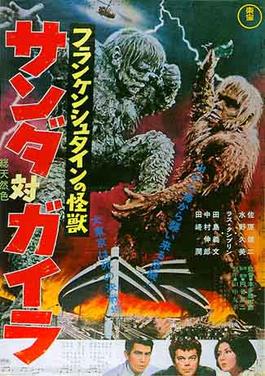
The War of the Gargantuas is a 1966 kaiju film directed by Ishirō Honda, with special effects by Eiji Tsuburaya. Referred by film historian Stuart Galbraith IV as a "quasi–sequel" to Frankenstein vs. Baragon, the film was a Japanese-American co-production; it was the third and final collaboration between Toho Co., Ltd and Henry G. Saperstein. The film stars Russ Tamblyn, Kumi Mizuno and Kenji Sahara, with Yû Sekida as Sanda and Haruo Nakajima as Gaira. In the film, scientists investigate the sudden appearance of two giant hairy humanoid monsters that culminates in a battle in Tokyo.
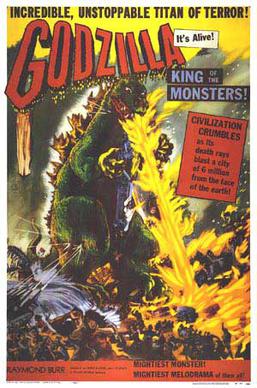
Godzilla, King of the Monsters! is a 1956 kaiju film directed by Terry O. Morse and Ishirō Honda, with special effects by Eiji Tsuburaya. It is a heavily re-edited American localization, or "Americanization", of the 1954 Japanese film Godzilla. The film was a Japanese-American co-production, with the original footage produced by Toho Co., Ltd., and the new footage produced by Jewell Enterprises. The film stars Raymond Burr, Takashi Shimura, Momoko Kōchi, Akira Takarada, and Akihiko Hirata, with Haruo Nakajima and Katsumi Tezuka as Godzilla. In the film, an American reporter covers a giant reptilian monster's attack on Japan.

Varan the Unbelievable is a 1958 Japanese kaiju film directed by Ishirō Honda, with special effects by Eiji Tsuburaya. Produced and distributed by Toho Co., Ltd, it stars Kōzō Nomura, Ayumi Sonoda, and Koreya Senda, with Haruo Nakajima as Varan. In the film, a reporter's investigation into two mysterious deaths in Japan's mountains leads to the discovery of a giant lake monster, wrecking its way towards civilization.
Godzilla: King of the Monsters in 3D was an unproduced American film project that was developed in 1983 by Steve Miner, with Miner attached to direct the film. Miner shopped the project around Hollywood and generated some interest, but was unable to secure funding and let the rights revert to Toho. The project was the first attempt to produce a Godzilla film at an American film studio.
